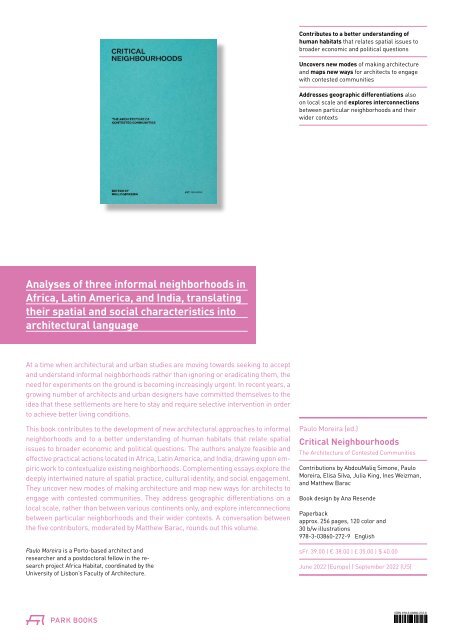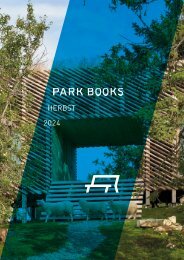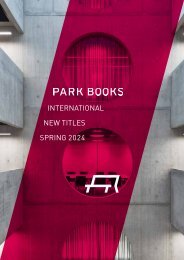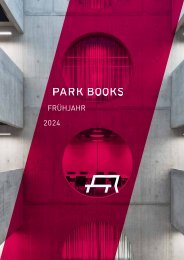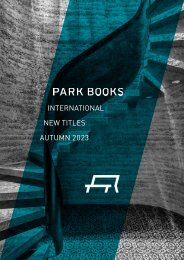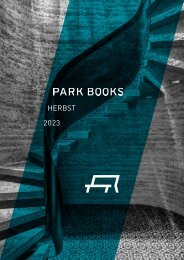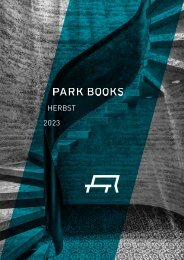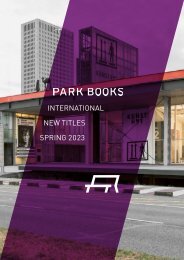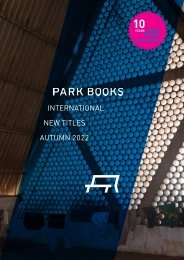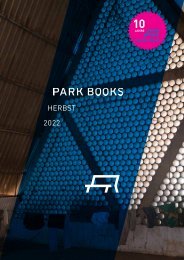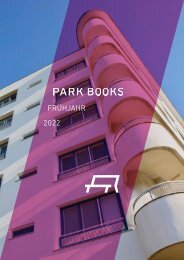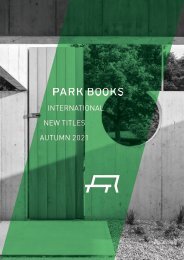Park Books International New Titles Spring 2022
You also want an ePaper? Increase the reach of your titles
YUMPU automatically turns print PDFs into web optimized ePapers that Google loves.
Contributes to a better understanding of<br />
human habitats that relates spatial issues to<br />
broader economic and political questions<br />
Uncovers new modes of making architecture<br />
and maps new ways for architects to engage<br />
with contested communities<br />
Addresses geographic differentiations also<br />
on local scale and explores interconnections<br />
between particular neighborhoods and their<br />
wider contexts<br />
Analyses of three informal neighborhoods in<br />
Africa, Latin America, and India, translating<br />
their spatial and social characteristics into<br />
architectural language<br />
At a time when architectural and urban studies are moving towards seeking to accept<br />
and understand informal neighborhoods rather than ignoring or eradicating them, the<br />
need for experiments on the ground is becoming increasingly urgent. In recent years, a<br />
growing number of architects and urban designers have committed themselves to the<br />
idea that these settlements are here to stay and require selective intervention in order<br />
to achieve better living conditions.<br />
This book contributes to the development of new architectural approaches to informal<br />
neighborhoods and to a better understanding of human habitats that relate spatial<br />
issues to broader economic and political questions. The authors analyze feasible and<br />
effective practical actions located in Africa, Latin America, and India, drawing upon empiric<br />
work to contextualize existing neighborhoods. Complementing essays explore the<br />
deeply intertwined nature of spatial practice, cultural identity, and social engagement.<br />
They uncover new modes of making architecture and map new ways for architects to<br />
engage with contested communities. They address geographic differentiations on a<br />
local scale, rather than between various continents only, and explore interconnections<br />
between particular neighborhoods and their wider contexts. A conversation between<br />
the five contributors, moderated by Matthew Barac, rounds out this volume.<br />
Paulo Moreira is a Porto-based architect and<br />
researcher and a postdoctoral fellow in the research<br />
project Africa Habitat, coordinated by the<br />
University of Lisbon’s Faculty of Architecture.<br />
Paulo Moreira (ed.)<br />
Critical Neighbourhoods<br />
The Architecture of Contested Communities<br />
Contributions by AbdouMaliq Simone, Paulo<br />
Moreira, Elisa Silva, Julia King, Ines Weizman,<br />
and Matthew Barac<br />
Book design by Ana Resende<br />
Paperback<br />
approx. 256 pages, 120 color and<br />
30 b/w illustrations<br />
978-3-03860-272-9 English<br />
sFr. 39.00 | € 38.00 | £ 35.00 | $ 40.00<br />
June <strong>2022</strong> (Europe) | September <strong>2022</strong> (US)<br />
ISBN 978-3-03860-272-9


